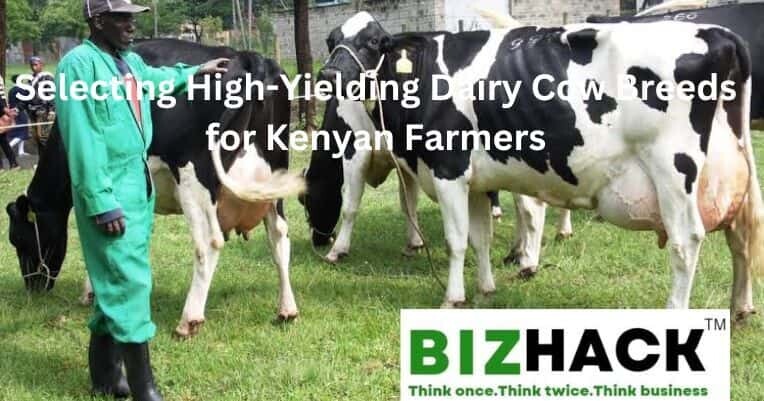Last updated on March 2nd, 2024 at 05:51 pm
In this article you will learn about selecting High-Yielding Dairy Cow Breeds for Kenyan Farmers.
As Kenya’s dairy industry continues to thrive, one crucial factor that determines the success of dairy farming is the selection of high-yielding dairy cow breeds. Choosing the right breed can significantly impact milk production and profitability for Kenyan farmers. In this article, we will delve into the key considerations for selecting dairy cow breeds that are known for their high milk yields, and provide valuable insights to help farmers make informed decisions.
Selecting High-Yielding Dairy Cow Breeds for Kenyan Farmers
1. Assessing the Local Environment
Before selecting a dairy cow breed, it’s essential to consider the local environment and climate conditions. Different breeds adapt differently to varying climates. Kenya has diverse agro-ecological zones, and farmers should choose breeds that can thrive in their specific area. For example, the Friesian breed is known for its adaptability to cooler regions, while the Sahiwal breed is better suited to hotter climates.
Also Checkout: Benefits of Genetic Selection in Dairy farming
2. Milk Production Potential
High milk yield is a primary consideration for Kenyan dairy farmers. Each breed has its own average milk production potential, typically measured in liters per lactation or per day. Holstein Friesians and Jerseys are renowned for their exceptional milk production, making them popular choices among farmers seeking high yields. However, it’s important to note that high milk production should be balanced with other factors, such as breed adaptability and feed efficiency.
3. Feed Efficiency and Nutritional Requirements:
Feed costs constitute a significant portion of dairy farming expenses. Opting for dairy cow breeds that efficiently convert feed into milk can greatly enhance profitability. Some breeds, such as the Guernsey and Ayrshire, exhibit good feed efficiency and can produce respectable milk yields while consuming less feed. Considering the availability of local feed resources and the breed’s nutritional requirements will aid in making an informed decision.
4. Disease Resistance and Health
Disease outbreaks can devastate dairy herds and lead to significant financial losses. Selecting breeds with inherent disease resistance can help mitigate this risk. Indigenous Kenyan breeds, such as the Boran and Sahiwal, have developed natural resistance to certain local diseases and pests. However, it’s crucial to strike a balance between disease resistance and milk production potential, as some indigenous breeds may have comparatively lower yields.
5. Longevity and Reproductive Performance
The longevity and reproductive performance of dairy cows directly impact their lifetime productivity. Kenyan farmers should look for breeds with good reproductive efficiency, including shorter calving intervals and higher conception rates. Holsteins and Jerseys are known for their reproductive prowess and longevity, but it’s important to consider the breed’s ability to withstand local environmental challenges.
Conclusion on Selecting High-Yielding Dairy Cow Breeds for Kenyan Farmers
Selecting high-yielding dairy cow breeds is a critical decision that can shape the success of dairy farming in Kenya. By considering factors such as local climate, milk production potential, feed efficiency, disease resistance, and reproductive performance, farmers can make informed choices that align with their specific goals and circumstances. It’s advisable to seek guidance from dairy experts, breeders, and fellow farmers who have experience with different breeds. Ultimately, a well-informed decision will lead to increased milk production, improved profitability, and a sustainable dairy industry in Kenya.
